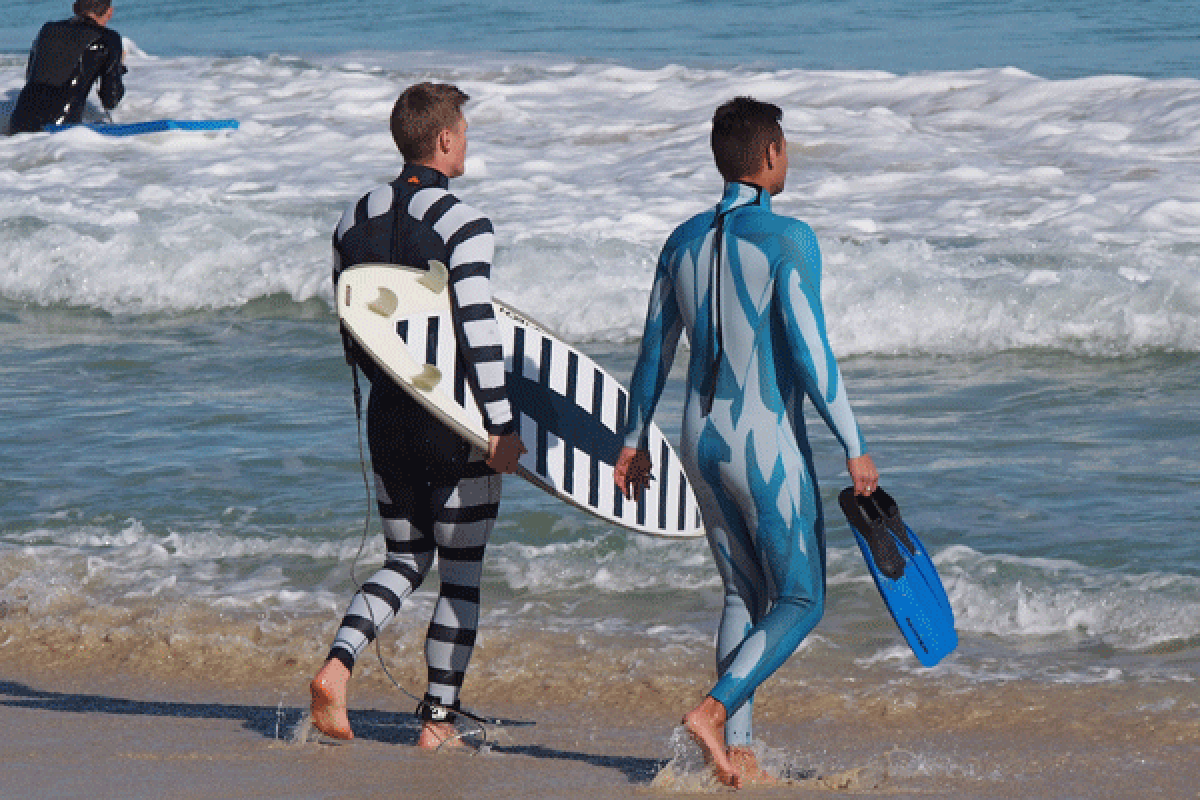‘Invisibility’ wetsuit promises protection in land of killer sharks

Can a wetsuit protect a diver from sharks? In Western Australia, where shark attacks (although still rare) have risen sharply, officials and scientists alike are testing whether the answer may lie in fashion.
So, when it comes to avoiding sharks, is it better to stand out or to fade into the background?
A “conspicuous” wetsuit with big white and deep-blue stripes on the arms and legs makes a diver obvious to sharks. A “cryptic” version has been likened to the Harry Potter invisibility cloak. It comes in shades of white, gray and aqua.
PHOTOS: Close brushes with shark
Will either work?
“I kind of have to chuckle,” said shark expert Chris Lowe, a professor at Cal State Long Beach.
“First of all, we really don’t know what motivates sharks to occasionally bite people,” said Lowe, who heads the university’s Sharklab. “That makes it kind of tough to come up with a ‘fits all’ solution -- be it an electric, chemical repellent, visual discourager or purported invisible cloak.”
Second, he said, “one of the favorite prey items of tiger sharks in Australia is sea snakes.” These poisonous snakes have a banding pattern. “Imagine swimming or paddling around looking like a giant sea snake. ... I think I would just prefer to look like a human in the water. We already have a very low chance of being bitten.”
The wetsuits were developed by Shark Attack Mitigation Systems (SAMS) in Perth, Australia, in conjunction with scientists from the University of Western Australia and Ray Smith, who was the original Quiksilver brand designer.
According to SAMS, wearing the suits should “significantly” reduce the risk of being attacked.
Some work by allowing the wearer “to effectively blend with background colors in the water,” making it hard for the shark to “detect or focus.” The blue suit can’t be seen by the shark, the makers maintain, because the fish are color blind. Others work by making the wearer “highly visible” and “totally unlike any normal prey.” In other words, the suit is supposed to scream, I am not a seal.
The Western Australia government was among investors in the project, according to SAMS, providing funds for initial research and development.
Perhaps the project seemed a better solution to officials than their original idea: Kill the sharks.
As the Los Angeles Times reported last fall, Western Australia reacted to the surge in fatalities from shark attacks with a plan to kill any shark that swam close to the beach, even great whites, which it usually protected as an endangered species.
Conservationists protested, and the clash brought up the often-pondered question: Is the risk of shark attacks on humans really that significant?
The headlines are horrifying. “Shark Bites 15-Year-Old French Girl in Half;” “Shark Attacks Pacifica Kayaker With ‘Pink Gums and His Teeth Bared’;” “Great White Shark Gets Head Into Shark Diving Cage.”
But shark experts have long maintained that the risk of attack is relatively low.
“It’s far more dangerous driving to the beach” than swimming in the ocean, Lowe said.
Still, run-ins between humans and sharks have become more common -- and Australia is notorious.
Lowe is among authors of the study “Responding to the Risk of White Shark Attack,” which shows that from 1876 to 2008 there were 346 unprovoked white shark attacks around the world.
“As human utilization of the ocean has increased over the last century,” the report states, “encounters with more dangerous species have become more frequent.”
PHOTOS: Close brushes with shark
Of the 346 unprovoked white shark attacks, 126 occurred in Australia, and 50 were fatal. By comparison, there were just eight reported in that time period in the eastern U.S.; four were fatal. The western U.S., however, was second on the list with 112 unprovoked attacks by great whites, and 12 of those were fatal.
It stands to reason that swimmers and divers in Australia would want to try out a wetsuit that just might protect them against shark attacks.
But, as Lowe pointed out, “devices or wetsuits like this might give people a false sense of security, encouraging them to put themselves in potentially more dangerous situations because they assume it works.”
“There simply are no guarantees when going in the ocean,” he said. “It isn’t Disneyland, it is a wild environment, with wild animals. So you have to just accept that fact that you are not always going to be safe. People simply need to use water smarts, enjoy and take care of the ocean.”
ALSO:
China selling baby bottles for adults
Celebrating Nelson Mandela’s 95th birthday
Dubai pays chubby citizens to drop some weight
More to Read
Start your day right
Sign up for Essential California for news, features and recommendations from the L.A. Times and beyond in your inbox six days a week.
You may occasionally receive promotional content from the Los Angeles Times.







